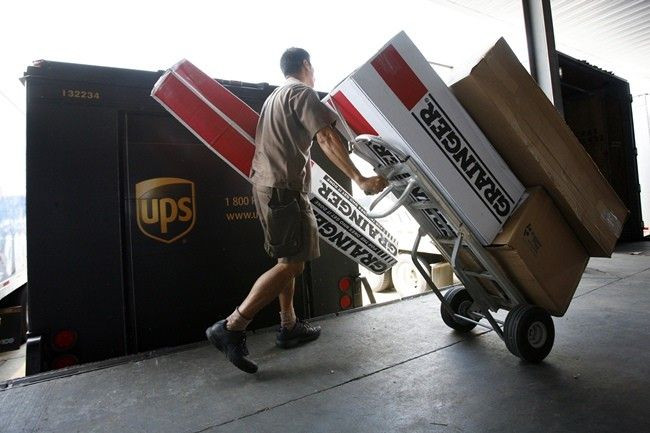UPS Is Waiving Delivery Surcharges For The Holidays

Christmas came a little early for online shoppers when UPS (NYSE:UPS) announced it won't impose delivery surcharges on residential orders this year. Because it has invested heavily in expansion and operational capabilities, the carrier says, it has increased efficiency enough that it doesn't need to moderate order flow this year.
Although that was a lucrative little fee tacked onto each package, UPS has expanded its capacity sufficiently and improved operations enough that it ought to make up for it through increased productivity.
Regulating the tsunami of holiday packages
The residential delivery surcharge was first imposed following the disastrous 2013 holiday season that saw well over 1 million packages remain undelivered by Christmas Day. Because of inane promises made by retailers that customers could order gifts close to the holiday and still get them in time, UPS and FedEx (NYSE:FDX) were swamped with packages that couldn't get delivered. In fact, some packages arrived well past New Year's Day.
CEO David Abney of UPS was quoted at the time as saying, "These pricing strategies will be designed to ensure we are properly compensated for the value we provide."
FedEx also imposed residential delivery surcharges, but beginning in 2016, it waived the extra fees, and did so again in 2017 and 2018. UPS, though, continued imposing a surcharge. While FedEx hasn't announced its intentions yet for the 2019 holiday period, it seems likely it won't impose them this year, either. After canceling contracts with Amazon.com (NASDAQ:AMZN) for express air delivery and ground delivery, it has opened up new capacity to target the rest of the e-commerce market.
Expanded capacity
UPS expects the holidays to be another big, record-setting time, but now it says it is prepared. Over the past two years, it has added 20 cargo planes, installed new automated sorting capacity at its "super hubs" that can handle an additional 700,000 packages per hour, and has updated its processing and delivery operations.
The carrier is now delivering packages seven days a week. It has partnered with CVS Health, Michaels arts and crafts stores, and Advance Auto Parts to install approximately 12,000 new access points for pickup and returns, bringing the total to 21,000 by year's end.
FedEx has similarly been expanding its capacity to meet the expected deluge. When the carrier began severing its relationship with Amazon, it said it expected e-commerce delivery demand to double to 100 million packages by 2026. Much of that will growth undoubtedly be driven by Amazon, there are many other retailers that will be exploiting online's potential that FedEx intends to capture.
Analysts believe Walmart was FedEx's primary target because the retailer is in a steel-cage death match with the e-commerce giant to grow its online sales footprint.
Competitive clouds on the horizon
The decision by UPS can be seen as showing the carrier's full confidence in its ability to meet its customers' needs and protect its own financial health. But it also indicates a still-fierce battle under way for market share between the two carriers, even as Amazon expands its own logistics and transportation capabilities.
In the past, UPS has said the surcharges would help it attain the level of service its customers expect during the November-to-December holiday period, while also offsetting the costs when package volumes nearly double. In 2017, analysts at Citibank believed the surcharges showed UPS was flexing its muscles in a hyper-consolidated market, an action they saw adding $60 million to $100 million of incremental revenue and operating profit, while also leading to a 3% to 5% increase in earnings per share.
The decision may also reflect the potential threat Amazon poses to the carriers. The e-commerce leader has only minimally dabbled in third-party delivery -- saying that its logistics ambitions are to serve its own customers better -- but it clearly wouldn't take much for Amazon to begin offering some of its growing capacity to third parties. So eliminating the surcharge ensures UPS rates remain competitive.
Offering some holiday cheer
While regular residential packages are getting a surcharge reprieve, UPS will continue to impose extra fees on heavy and oversize items, with FedEx undoubtedly doing the same. That at least moves the expense onto what are unprofitable -- or at the least very costly -- items to ship.
Regardless of the reason behind UPS waiving the surcharges, the development means investors should feel confident the carrier is in a much better place than it was even last year. It has new, expanded facilities that will handle 75% of the packages it will deliver this Christmas and it may see a bump in volume after FedEx abandoned Amazon, allowing UPS to operate at an enhanced level of efficiency.
Beyond the benefit to consumers, the announcement means UPS is delivering at least one holiday present to investors too.
This article originally appeared in the Motley Fool.
Rich Duprey has no position in any of the stocks mentioned. The Motley Fool owns shares of and recommends Amazon and FedEx. The Motley Fool recommends CVS Health and Michaels Stores. The Motley Fool has a disclosure policy.




















